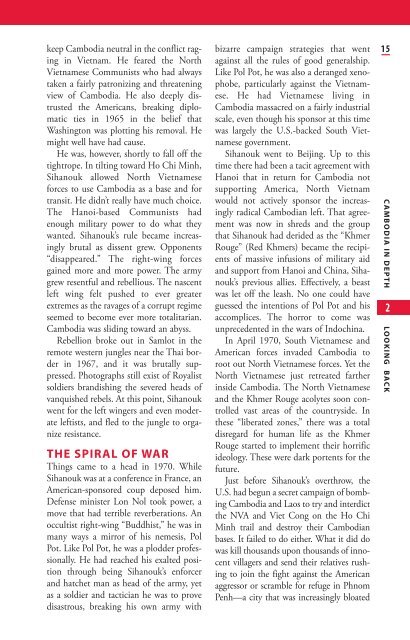Create successful ePaper yourself
Turn your PDF publications into a flip-book with our unique Google optimized e-Paper software.
keep <strong>Cambodia</strong> neutral in the conflict raging<br />
in Vietnam. He feared the North<br />
Vietnamese Communists who had always<br />
taken a fairly patronizing and threatening<br />
view <strong>of</strong> <strong>Cambodia</strong>. He also deeply distrusted<br />
the Americans, breaking diplomatic<br />
ties in 1965 in the belief that<br />
Washington was plotting his removal. He<br />
might well have had cause.<br />
He was, however, shortly to fall <strong>of</strong>f the<br />
tightrope. In tilting toward Ho Chi Minh,<br />
Sihanouk allowed North Vietnamese<br />
forces to use <strong>Cambodia</strong> as a base and for<br />
transit. He didn’t really have much choice.<br />
<strong>The</strong> Hanoi-based Communists had<br />
enough military power to do what they<br />
wanted. Sihanouk’s rule became increasingly<br />
brutal as dissent grew. Opponents<br />
“disappeared.” <strong>The</strong> right-wing forces<br />
gained more and more power. <strong>The</strong> army<br />
grew resentful and rebellious. <strong>The</strong> nascent<br />
left wing felt pushed to ever greater<br />
extremes as the ravages <strong>of</strong> a corrupt regime<br />
seemed to become ever more totalitarian.<br />
<strong>Cambodia</strong> was sliding toward an abyss.<br />
Rebellion broke out in Samlot in the<br />
remote western jungles near the Thai border<br />
in 1967, and it was brutally suppressed.<br />
Photographs still exist <strong>of</strong> Royalist<br />
soldiers brandishing the severed heads <strong>of</strong><br />
vanquished rebels. At this point, Sihanouk<br />
went for the left wingers and even moderate<br />
leftists, and fled to the jungle to organize<br />
resistance.<br />
THE SPIRAL OF WAR<br />
Things came to a head in 1970. While<br />
Sihanouk was at a conference in France, an<br />
American-sponsored coup deposed him.<br />
Defense minister Lon Nol took power, a<br />
move that had terrible reverberations. An<br />
occultist right-wing “Buddhist,” he was in<br />
many ways a mirror <strong>of</strong> his nemesis, Pol<br />
Pot. Like Pol Pot, he was a plodder pr<strong>of</strong>essionally.<br />
He had reached his exalted position<br />
through being Sihanouk’s enforcer<br />
and hatchet man as head <strong>of</strong> the army, yet<br />
as a soldier and tactician he was to prove<br />
disastrous, breaking his own army with<br />
bizarre campaign strategies that went<br />
against all the rules <strong>of</strong> good generalship.<br />
Like Pol Pot, he was also a deranged xenophobe,<br />
particularly against the Vietnamese.<br />
He had Vietnamese living in<br />
<strong>Cambodia</strong> massacred on a fairly industrial<br />
scale, even though his sponsor at this time<br />
was largely the U.S.-backed South Vietnamese<br />
government.<br />
Sihanouk went to Beijing. Up to this<br />
time there had been a tacit agreement with<br />
Hanoi that in return for <strong>Cambodia</strong> not<br />
supporting America, North Vietnam<br />
would not actively sponsor the increasingly<br />
radical <strong>Cambodia</strong>n left. That agreement<br />
was now in shreds and the group<br />
that Sihanouk had derided as the “Khmer<br />
Rouge” (Red Khmers) became the recipients<br />
<strong>of</strong> massive infusions <strong>of</strong> military aid<br />
and support from Hanoi and China, Sihanouk’s<br />
previous allies. Effectively, a beast<br />
was let <strong>of</strong>f the leash. No one could have<br />
guessed the intentions <strong>of</strong> Pol Pot and his<br />
accomplices. <strong>The</strong> horror to come was<br />
unprecedented in the wars <strong>of</strong> Indochina.<br />
In April 1970, South Vietnamese and<br />
American forces invaded <strong>Cambodia</strong> to<br />
root out North Vietnamese forces. Yet the<br />
North Vietnamese just retreated farther<br />
inside <strong>Cambodia</strong>. <strong>The</strong> North Vietnamese<br />
and the Khmer Rouge acolytes soon controlled<br />
vast areas <strong>of</strong> the countryside. In<br />
these “liberated zones,” there was a total<br />
disregard for human life as the Khmer<br />
Rouge started to implement their horrific<br />
ideology. <strong>The</strong>se were dark portents for the<br />
future.<br />
Just before Sihanouk’s overthrow, the<br />
U.S. had begun a secret campaign <strong>of</strong> bombing<br />
<strong>Cambodia</strong> and <strong>Laos</strong> to try and interdict<br />
the NVA and Viet Cong on the Ho Chi<br />
Minh trail and destroy their <strong>Cambodia</strong>n<br />
bases. It failed to do either. What it did do<br />
was kill thousands upon thousands <strong>of</strong> innocent<br />
villagers and send their relatives rushing<br />
to join the fight against the American<br />
aggressor or scramble for refuge in Phnom<br />
Penh—a city that was increasingly bloated<br />
15<br />
CAMBODIA IN DEPTH 2<br />
LOOKING BACK










